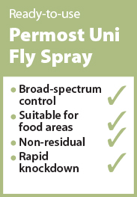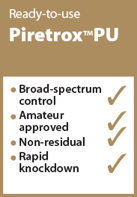Housefly
(Musca domestica)
The common housefly is present all over the world and can cause significant health issues, as well as nuisance, to humans. Flies can be found in areas with suitable breeding conditions, such as places with rotting or fermenting moist organic matter. The housefly is known to transmit enteritic diseases and intestinal parasitic worms.
Life cycle:
Complete metamorphosis
| Eggs | Eggs are laid in batches of around 150, in rotting or fermenting moist organic matter. The eggs are whitish and oval in appearance, around 1mm in length. Eggs will typically hatch between 8-48 hours. |
| Larva | The larva are around 12mm in length; they have three moults before pupating. As the larva goes through this process, it feeds on semi-liquid food and gradually moves towards a dry area. This larval stage typically takes 1-2 weeks, however can range from 5-30 days, depending on the food source and temperature. |
| Pupa | The pupae is the final stage before metamorphosis into the adult. Pupae is reddish-brown in colour and can be found in soil or a dry area. Development usually takes 1-2 weeks. |
| Adult | The adult flies are around 6mm in size. Greyish in colour with pale stripes on the thorax, a yellow underside and large red coloured eyes. The typical lifespan of an adult fly is from 14-30 days. |
Habitat
Houseflies are found throughout the world, typically around areas of human activity. Areas such as refuse and intensive animal production sites, such as poultry sheds provide the ideal environment for breeding. The fly life cycle can be as short as 14 days, but possibly up to around 90 days.








